Lattice Planner從學習到放棄(二):二次規劃的應用與偵錯
前言
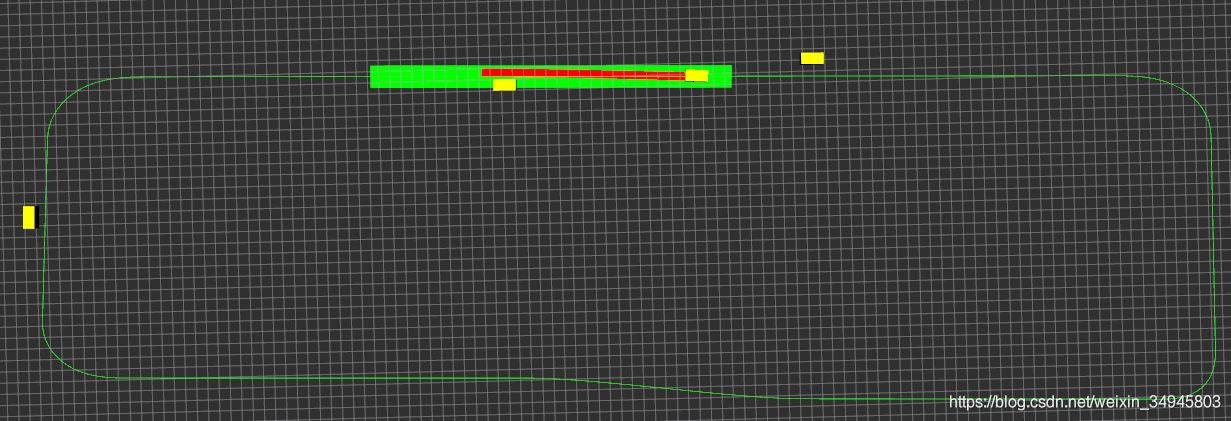
前情提要:Lattice Planner從學習到放棄
盲目激情的移植apollo的lattice,體會到了痛苦,當時為了先儘快讓lattice演演算法在自己的框架裡跑起來,在摘用原始碼的時候做了很多欠考慮的改動,雖然快速實現了通過lattice planner規劃軌跡,然後達到循跡的效果,但是在隨後引入障礙物,產生了大量的坑,深深的被教育,也給帶頭大哥添了不少麻煩。
看懂流程==>理解原理 ==>成功實現
最終通過planner中的二次規劃實現了單車道內低速障礙物的避讓規劃。
簡明扼要:新增靜態障礙物→產生單車道內目標軌跡→繞行或停止
最近節奏比較撕裂,下午或晚上才能搞lattice的復現,但這個「重複造輪子」的過程真的獲益良多,和大哥們交流也多起來,知道好的輪子是什麼樣的,才能嘗試去改進或完善,一瓶不響半瓶咣噹,半瓶正是在下~保持積極與熱情,也期待大佬們各種指導....
一.靜態障礙物的引入
1.障礙物的格式
暫時不使用Apollo的那套,先用自有結構體接收障礙物資訊,然後壓入Obstacle類中即可。
對於靜態或低速障礙物,無非就是id、長寬高、位置以及朝向,動態障礙物暫時沒有進行。
2.自車sl的建立和障礙物的建立
自車相對於參考線起點裡程和橫向偏移量,以及障礙物的ST、SL資訊都是要計算的,對於動態障礙物,SL已經不足以滿足需求了吧?後續學習EM再拎出來分析。
二.單車道場景中面向靜態障礙物的避讓
1.軌跡規劃原理
軌跡=縱向軌跡+橫向軌跡,之前已經分析了縱向速度規劃的過程,以及橫縱向軌跡是如何combine成一條完整軌跡的。在lattice中,橫向軌跡生成有兩種方法:撒點取樣法、二次規劃法。
1.1基於取樣點的軌跡規劃

撒點法前邊也有記錄,知道了起始點和取樣點的 ,然後求解對應的五次多項式的係數,便可得到對應的橫向軌跡,不重複了。
,然後求解對應的五次多項式的係數,便可得到對應的橫向軌跡,不重複了。
1.2基於二次規劃的軌跡規劃
Apollo原始碼中FLAGS_lateral_optimization預設是開啟的,即橫向規劃預設使用二次規劃進行,由於個人魯莽認為撒點會更直觀簡潔,所以關了這個標誌位,採用的是撒點取樣,隨後在實車偵錯時發現耗時很大,尤其是自車接近障礙物時,耗時飆升——軌跡數太多,障礙物碰撞檢測遍歷軌跡。額,設定比較低的工控機雪上加霜...然後試用一下二次規劃唄,wtf,超nice。
學習了程十三的軌跡規劃綜述。
Apollo中二次規劃求解使用的是OSQP求解器,官網:OSQP官網點這裡 ,二次規劃求解有很多方法,關於為何選取OSQP,速度快~為何這麼快,數學系的大佬們的戰場。標準的二次規劃形式:

下來要做的就很明確了:
- 搞清楚路徑規劃的約束;
- 搞清楚優化目標,即如何評價計算結果的優劣
- 轉換成osqp求解器需要的形式,呼叫求解器
- 坐等結果~
考慮車寬以及和障礙物的距離buffer,車輛的中心的橫向可移動範圍大概就是如下圖,Apollo中,前探60m,取樣點間隔1m,所以有60個取樣點,也可以根據實際情況調整。
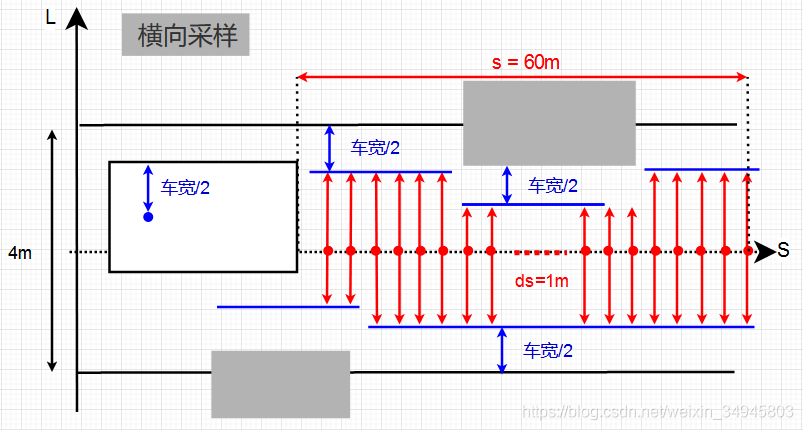
1.2.1 車輛橫向狀態量設計
橫向偏移量 作為基本量,跑不掉,
作為基本量,跑不掉,![]() 作為橫向速度變化率,當然也跑不掉;
作為橫向速度變化率,當然也跑不掉; 作為橫向加加速度,是控制乘坐舒適性的重要指標,也不能放掉;對於
作為橫向加加速度,是控制乘坐舒適性的重要指標,也不能放掉;對於 ,把軌跡看作可拉伸的彈力繩,三階導意味著其可拉伸的程度,可以用
,把軌跡看作可拉伸的彈力繩,三階導意味著其可拉伸的程度,可以用 差分計算。so,需要的量齊全了。狀態量可以得到:
差分計算。so,需要的量齊全了。狀態量可以得到:
![x=[l_{59}, l_{58} ,..., l_{0}, l_{59}', l_{58}' ,..., l_{0}', l_{59}'', l_{58}'' ,..., l_{0}'' ]^{T}](https://s3.ap-northeast-1.wasabisys.com/img.tw511.com/202010/gifnt3ackxbvbl.gif)
1.2.2 車輛橫向軌跡約束的建立
整個約束建立主要考慮到:
1.自車不能與障礙物碰撞或駛出邊界,即![l_{i}\in [l_{i_{left}} , l_{i_{right}}]](https://s3.ap-northeast-1.wasabisys.com/img.tw511.com/202010/giftgjzllzy1xs.gif)
2.軌跡應該保持連續,即相鄰兩個取樣點的
3.軌跡應該保持光滑,即導數連續相鄰兩個取樣點的斜率
4.橫向加加速度(相對於s的二階偏導)應在一定範圍內,即![\small l_{i}'''=\frac{\Delta l_{i}''}{\Delta s}=\frac{l_{i+1}''-l_{i}''}{\Delta s}\in [-0.1,0.1]](https://s3.ap-northeast-1.wasabisys.com/img.tw511.com/202010/gifzbq2jiq2vv4.gif)
公式2、3直接用的泰勒公式進行的2階和3階展開,將代入,可得到公式2和3的最終形式:

到這一步,基本上約束的內容已經很清晰了,整理後如下:

即對於每一個取樣點,存在兩個不等式和兩個等式約束,一共60個取樣點,那麼約束至少應該為60x4=240個約束條件。
根據狀態量的形式,約束矩陣 也就定了(這裡不一定準確,若有不對求指導額..):
也就定了(這裡不一定準確,若有不對求指導額..):
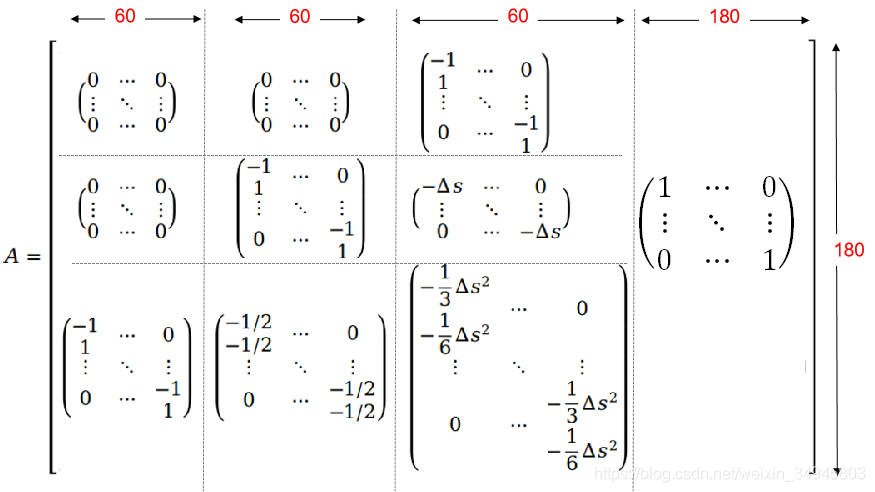
這裡使用的話貌似應該是 ,行列貌似反了...不管了,原理不變。
,行列貌似反了...不管了,原理不變。
1.2.3 約束邊界的建立
前邊已經描述了約束的建立依據,根據障礙物對車道的侵佔情況,更新橫向位移![]() 的範圍,最終約束的上下邊界分別為:
的範圍,最終約束的上下邊界分別為:
![bound_{up}=[0.1, 0.1, ...,0.1,0,0,...,0,0,0,...,0,1.45,1.45,...,1.45,2,2,...,2]^{T}](https://s3.ap-northeast-1.wasabisys.com/img.tw511.com/202010/gifkox45qybjmj.gif)
![bound_{low}=[-0.1, -0.1, ...,-0.1,0,0,...,0,0,0,...,0,-1.45,-1.45,...,-1.45,-2,-2,...,-2]^{T}](https://s3.ap-northeast-1.wasabisys.com/img.tw511.com/202010/gift30awwsilg1.gif)
其中-2,2作為預設值不充值,湊夠矩陣運算數量,最終用於:

1.2.3 目標函數的建立
二次規劃的目標為

其中,將權重作為P項對角陣傳入,左右邊界作為偏差項q用以控制軌跡和參考線的偏離程度,如下:

![q=[-2W_{LateralOffset}(l_-bound[0].first+l_-bound[0].second),...,-2W_{LateralOffset}(l_-bound[59].first+l_-bound[59].second)]](https://s3.ap-northeast-1.wasabisys.com/img.tw511.com/202010/gift0unm5wupiw.gif)
至此,整個二次規劃建立所需要的材料,全部齊全。在二次規劃中,對於矩陣P,以目前形式來看一定是正定的額,是否意味著此問題是凸優化問題,且一定有可行解?求大佬指點。。。
1.2.5 約束矩陣的壓縮CSC
從上邊已經可以看到,建立起來的矩陣基本都非常稀疏,在運算過程中是非常不方便的,常見的稀疏矩陣壓縮方法主要有:
- CSR—Compressed sparse row
- CSC—Compressed sparse column
之前在學習apollo時,發現其採用的csc矩陣,當時並不瞭解,也是擴充套件後才知道,可見總結:csc_matrix稀疏矩陣理解 至於為何選擇csc的原因可能是osqp官方使用的是csc?呼叫osqp建立workspace,需要以csc矩陣形式傳入求解器。
閒話一大堆,下面上程式碼。
2.Lattice planning二次規劃程式碼實現
lattice planner中通過呼叫Trajectory1dGenerator範例化後的成員函數,生成橫縱向軌跡,我們要看的常規撒點法和二次規劃都在其中,
// 5. generate 1d trajectory bundle for longitudinal and lateral respectively.
Trajectory1dGenerator trajectory1d_generator(
init_s, init_d, ptr_path_time_graph, ptr_prediction_querier);
std::vector<std::shared_ptr<Curve1d>> lon_trajectory1d_bundle;
std::vector<std::shared_ptr<Curve1d>> lat_trajectory1d_bundle;
trajectory1d_generator.GenerateTrajectoryBundles(
planning_target, &lon_trajectory1d_bundle, &lat_trajectory1d_bundle);
進入函數後,很清晰沒啥說的:縱向規劃+橫向規劃。
void Trajectory1dGenerator::GenerateTrajectoryBundles(
const PlanningTarget& planning_target,
Trajectory1DBundle* ptr_lon_trajectory_bundle,
Trajectory1DBundle* ptr_lat_trajectory_bundle) {
//縱向速度規劃
GenerateLongitudinalTrajectoryBundle(planning_target,
ptr_lon_trajectory_bundle);
//橫向軌跡規劃
GenerateLateralTrajectoryBundle(ptr_lat_trajectory_bundle);
}在橫向規劃內,通過宏定義FLAGS_lateral_optimization,決定是否採用二次規劃,如下:
void Trajectory1dGenerator::GenerateLateralTrajectoryBundle(
Trajectory1DBundle* ptr_lat_trajectory_bundle) const {
//是否使用優化軌跡,true,採用五次多項式規劃
if (!FLAGS_lateral_optimization) {
auto end_conditions = end_condition_sampler_.SampleLatEndConditions();
// Use the common function to generate trajectory bundles.
GenerateTrajectory1DBundle<5>(init_lat_state_, end_conditions,
ptr_lat_trajectory_bundle);
} else {
double s_min = init_lon_state_[0];
double s_max = s_min + FLAGS_max_s_lateral_optimization;//FLAGS_max_s_lateral_optimization = 60
double delta_s = FLAGS_default_delta_s_lateral_optimization;//規劃間隔為1m
//橫向邊界
auto lateral_bounds =
ptr_path_time_graph_->GetLateralBounds(s_min, s_max, delta_s);
// LateralTrajectoryOptimizer lateral_optimizer;
std::unique_ptr<LateralQPOptimizer> lateral_optimizer(
new LateralOSQPOptimizer);
// 採用的是OSQP求解器
lateral_optimizer->optimize(init_lat_state_, delta_s, lateral_bounds);
auto lateral_trajectory = lateral_optimizer->GetOptimalTrajectory();
ptr_lat_trajectory_bundle->push_back(
std::make_shared<PiecewiseJerkTrajectory1d>(lateral_trajectory));
}
}流程很直白,通過GetLateralBounds函數獲取包含障礙物資訊的橫向邊界分佈,然後傳入lateral_optimizer->optimize()中開始osqp短暫愉快的一生,

完整原始碼可看apollo:
bool LateralOSQPOptimizer::optimize(
const std::array<double, 3>& d_state, const double delta_s,
const std::vector<std::pair<double, double>>& d_bounds) {
std::vector<c_float> P_data;
std::vector<c_int> P_indices;
std::vector<c_int> P_indptr;
//建立目標函數中的P矩陣,主要包括權重分配
CalculateKernel(d_bounds, &P_data, &P_indices, &P_indptr);
delta_s_ = delta_s; //1m
const int num_var = static_cast<int>(d_bounds.size());
const int kNumParam = 3 * static_cast<int>(d_bounds.size());
const int kNumConstraint = kNumParam + 3 * (num_var - 1) + 3;
c_float lower_bounds[kNumConstraint];
c_float upper_bounds[kNumConstraint];
const int prime_offset = num_var;
const int pprime_offset = 2 * num_var;//=6?
std::vector<std::vector<std::pair<c_int, c_float>>> columns;
columns.resize(kNumParam);
int constraint_index = 0;
//constraint_index:0~2
// d_i+1'' - d_i''
for (int i = 0; i + 1 < num_var; ++i) {
columns[pprime_offset + i].emplace_back(constraint_index, -1.0);
columns[pprime_offset + i + 1].emplace_back(constraint_index, 1.0);
//FLAGS_lateral_third_order_derivative_max=0.1
lower_bounds[constraint_index] =
-FLAGS_lateral_third_order_derivative_max * delta_s_;
upper_bounds[constraint_index] =
FLAGS_lateral_third_order_derivative_max * delta_s_;
++constraint_index;
}
//constraint_index:3~5
// d_i+1' - d_i' - 0.5 * ds * (d_i'' + d_i+1'')
for (int i = 0; i + 1 < num_var; ++i) {
columns[prime_offset + i].emplace_back(constraint_index, -1.0);
columns[prime_offset + i + 1].emplace_back(constraint_index, 1.0);
columns[pprime_offset + i].emplace_back(constraint_index, -0.5 * delta_s_);
columns[pprime_offset + i + 1].emplace_back(constraint_index,
-0.5 * delta_s_);
lower_bounds[constraint_index] = 0.0;
upper_bounds[constraint_index] = 0.0;
++constraint_index;
}
//constraint_index:6~8
// d_i+1 - d_i - d_i' * ds - 1/3 * d_i'' * ds^2 - 1/6 * d_i+1'' * ds^2
for (int i = 0; i + 1 < num_var; ++i) {
columns[i].emplace_back(constraint_index, -1.0);
columns[i + 1].emplace_back(constraint_index, 1.0);
columns[prime_offset + i].emplace_back(constraint_index, -delta_s_);
columns[pprime_offset + i].emplace_back(constraint_index,
-delta_s_ * delta_s_ / 3.0);
columns[pprime_offset + i + 1].emplace_back(constraint_index,
-delta_s_ * delta_s_ / 6.0);
lower_bounds[constraint_index] = 0.0;
upper_bounds[constraint_index] = 0.0;
++constraint_index;
}
columns[0].emplace_back(constraint_index, 1.0);
lower_bounds[constraint_index] = d_state[0];//d
upper_bounds[constraint_index] = d_state[0];
++constraint_index;
columns[prime_offset].emplace_back(constraint_index, 1.0);
lower_bounds[constraint_index] = d_state[1];//d'
upper_bounds[constraint_index] = d_state[1];
++constraint_index;
columns[pprime_offset].emplace_back(constraint_index, 1.0);
lower_bounds[constraint_index] = d_state[2];//d''
upper_bounds[constraint_index] = d_state[2];
++constraint_index;
const double LARGE_VALUE = 2.0;
for (int i = 0; i < kNumParam; ++i) {
columns[i].emplace_back(constraint_index, 1.0);
if (i < num_var) {
lower_bounds[constraint_index] = d_bounds[i].first;
upper_bounds[constraint_index] = d_bounds[i].second;
} else {
lower_bounds[constraint_index] = -LARGE_VALUE;
upper_bounds[constraint_index] = LARGE_VALUE;
}
++constraint_index;
}
CHECK_EQ(constraint_index, kNumConstraint);
// change affine_constraint to CSC format
std::vector<c_float> A_data;
std::vector<c_int> A_indices;
std::vector<c_int> A_indptr;
int ind_p = 0;
for (int j = 0; j < kNumParam; ++j) {
A_indptr.push_back(ind_p);
for (const auto& row_data_pair : columns[j]) {
A_data.push_back(row_data_pair.second);
A_indices.push_back(row_data_pair.first);
++ind_p;
}
}
A_indptr.push_back(ind_p);
// offset
double q[kNumParam];
for (int i = 0; i < kNumParam; ++i) {
if (i < num_var) {
q[i] = -2.0 * FLAGS_weight_lateral_obstacle_distance *
(d_bounds[i].first + d_bounds[i].second);
} else {
q[i] = 0.0;
}
}
// Problem settings
OSQPSettings* settings =
reinterpret_cast<OSQPSettings*>(c_malloc(sizeof(OSQPSettings)));
// Define Solver settings as default
osqp_set_default_settings(settings);
settings->alpha = 1.0; // Change alpha parameter
settings->eps_abs = 1.0e-05;
settings->eps_rel = 1.0e-05;
settings->max_iter = 5000;
settings->polish = true;
settings->verbose = FLAGS_enable_osqp_debug;
// Populate data
OSQPData* data = reinterpret_cast<OSQPData*>(c_malloc(sizeof(OSQPData)));
data->n = kNumParam;
data->m = kNumConstraint;
data->P = csc_matrix(data->n, data->n, P_data.size(), P_data.data(),
P_indices.data(), P_indptr.data());
data->q = q;
data->A = csc_matrix(data->m, data->n, A_data.size(), A_data.data(),
A_indices.data(), A_indptr.data());
data->l = lower_bounds;
data->u = upper_bounds;
// Workspace
OSQPWorkspace* work = osqp_setup(data, settings);
// Solve Problem
osqp_solve(work);
// extract primal results
// prime求導符號
for (int i = 0; i < num_var; ++i) {
opt_d_.push_back(work->solution->x[i]);
opt_d_prime_.push_back(work->solution->x[i + num_var]);
opt_d_pprime_.push_back(work->solution->x[i + 2 * num_var]);
}
opt_d_prime_[num_var - 1] = 0.0;
opt_d_pprime_[num_var - 1] = 0.0;
// Cleanup
osqp_cleanup(work);
c_free(data->A);
c_free(data->P);
c_free(data);
c_free(settings);
return true;
}三、偵錯過程記錄
1.程式碼缺失與完善
偵錯過程中發現各種遺漏或者錯誤,改就是了...
2.實車執行失敗案例與分析
記錄下偵錯過程中失敗的過程。
2.1 車輛遇到貼近的障礙物:一直想往上撞
計算耗時無法控制,一旦接近障礙物,由於備選軌跡很多,並且每個軌跡都要進行碰撞檢測,外加工控機效能有限,導致耗時飆至900ms,已經嚴重不符100ms的運算週期了,直接導致軌跡拼接不準確,控制和規劃無法很好銜接。
但是有一點沒想通:即使軌跡拼接出問題,為何會往障礙物上撞,暫時把這個問題擱置了,後續解決。
2.2 使用二次規劃,貼近障礙物時無解,軌跡飛掉
(a)權重不合理,導致軌跡規劃無解
發現在和障礙物平齊時,自車橫向偏移量 總是比邊界多了0.1m....然後求解失敗
總是比邊界多了0.1m....然後求解失敗
畫個圖,一切明瞭,就像那高爾夫球進洞,或者《信條》裡的逆向子彈,如果軌跡有偏差,子彈是無法退回槍膛的,只會和槍管發生碰撞。

解決方法比較簡單,調節權重,提高自車和障礙物距離的權重,使得生成的軌跡適當遠離障礙物,從紅色變為綠色線。
(b)過早的轉彎,導致與障礙物發生碰撞
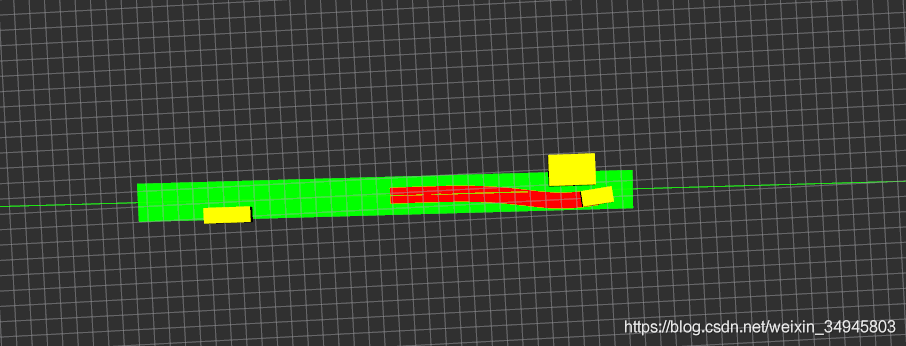
這裡問題根源還沒鎖定,可能因素有兩塊:
- 控制在選取預瞄距離後,過早的進行了轉向控制
- 規劃的軌跡的確過早轉向(這樣的話就不滿足求解約束了額,可能性不大)
不知有前輩怎麼解決的。
2.3 在特定的幾個點,軌跡直接飛掉,約束失效
車輛到某些位置會出現規劃失敗的情形,無法產生有效軌跡。為了查原因,關閉了軌跡有效性檢測,然後發現軌跡是這個diao樣子....飛掉了
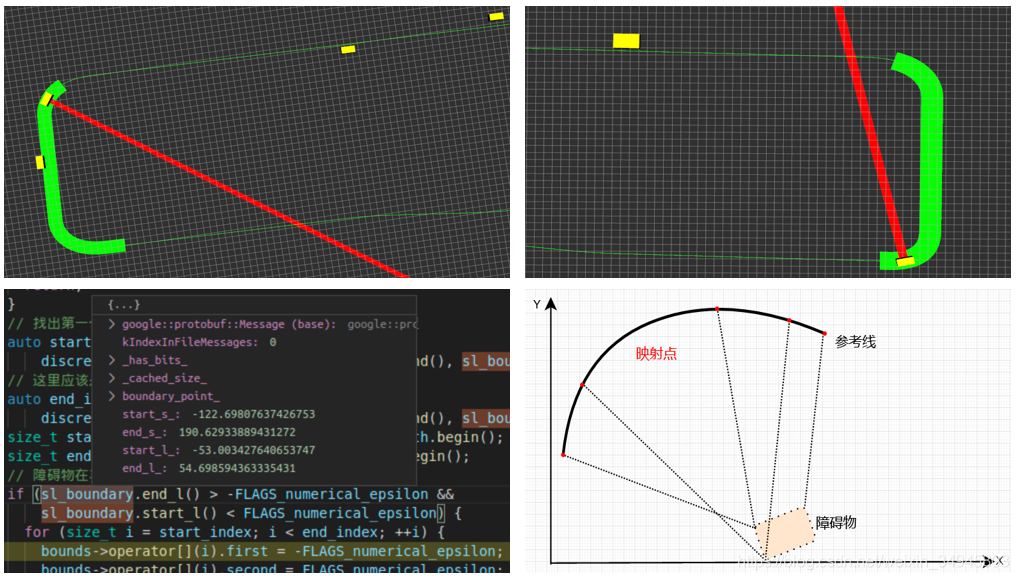
檢視該處的障礙物SL資訊,發現SL完全亂掉了。回想Frenet座標系在面對U型彎圓心處障礙物投影特點(障礙物會被極大拉伸),在出問題的點,該位置處參考線為圓弧形,障礙物恰好位於其圓心附近,導致障礙物在frennet投影時出現了右下圖所示,存在多個投影點,其SL圖當然是要廢掉了。
總結
目前已經實現了單車道內障礙物的規避,包括繞行和減速以及停車。一套下來,雖然只是簡單的功能復現,僅僅冰山一角但已經收益頗豐,實際操作的過程難度和踩坑大幅超過了自己的預期,多虧了身邊大哥的指導和幫助,開發工作真的是需要多交流與溝通。
下一階段目標:
實現多車道的軌跡規劃,園區內可以採用偽車道,即單條referenceline進行擴幅,覆蓋整條道路寬度即可,另一個是真實的多車道多referenceline,繼續加油,一點點進步。